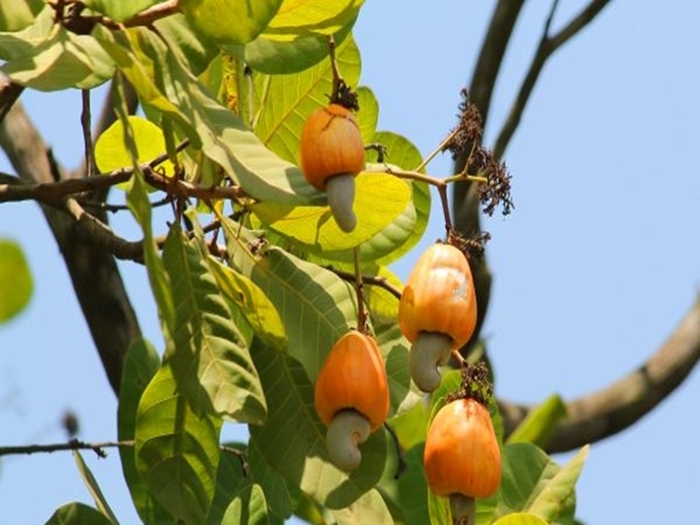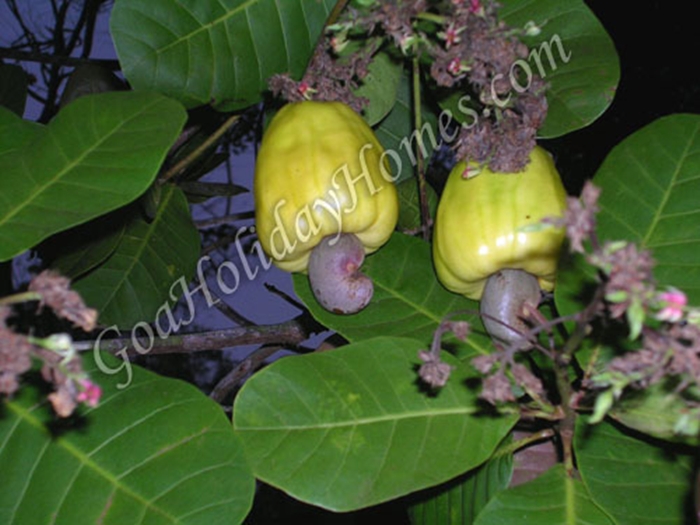The Coconut And The Cashew

The coconut palm and the cashew fruit hold a very significant place in the heart of every Goan. They are grown extensively as major crops especially for the sap or juice from which Goa' famous drink called Maddi or Feni is produced.
The significance of the former, i.e the coconut palm is very huge, every part of the tree is used for some or the other purpose e.g husks provide coir for manufacture of various handicrafts like ropes, mats etc. This coir is also used in manufacture of fishing nets, which is a source of livelihood of many people in Goa. The kopra is important in the perspective that it is a source of cooking oil, cosmetic and industrial products.
Its fronds are used for making baskets and thatching for roofs. The nut is the most important product, which serves as a cooking ingredient. The milk extracted from the white kernel, boiled and strained is an important ingredient in the famous Goan fish curry. The coconut, when tender, has refreshing water within its shell which is highly nutritive and delicious. The juice from the palm is fermented and serves as "Toddy" or Maddi in many tavernas in Goa and is also exported abroad.
Coconut production boosts the Goan economy in a large way and is grown extensively, i.e more than 100 millions! There is quite a lot of effort involved into growing palms as the crop requires the right amount of fertilizers and a lot of attention to prevent any spoilage.
The demand for palm feni is quite heavy and it is for this reason, that toddy from the palm is extracted. Unfermented toddy is very sweet and nourishing drink. Strained and boiled to crystallizing point, it produces palm jaggery, an important brown coarse form of sugar, used in making Goan sweet delicacies. The first fermentation of the toddy produces "urrak" which is quite popular in Goan tavernas while the second distillation produces the most sought after Palm Feni which is pure & quite high in alcohol content, highly ranked amongst the highest spirits. Both the Cashew and the Coconut are important in their own way but during the monsoon, coconut extraction from the palm comes to a still mostly due to the wind and slippery moss growing on the tree bark. Tapping is deemed to be beneficial in a way that it helps in refining of the palm tree. Overall, the coconut palm is rightly known as the Kalpavriksha or the "all giving" due to its multi benefits.
The significance of the cashew to the Goan economy is equivalent to that of the coconut palm. It is the most sought after commercial crop and is widely grown especially for its nuts and juice whether natural or fermented to produce feni.
It is a major contributor to the foreign market specially because of its salted and roasted nuts which are enjoyed all over the world. Cashew nuts from Goa are exported in millions abroad and in a large way, boost foreign trade. The cashew feni, just like the coconut toddy, is a major product sold in Goan bars and taverns. Cashews are grown in uncluttered masses scattered all over easily recognized by the dark shiny evergreen leaves around them. The cashew fruit is not so much relished by humans, and serves as a source of pig food. Cashew nut oil is used in various industrial uses. The juice of the cashew fruit is the source of obtaining the liquid from which cashew feni is obtained. The extraction of cashew feni is quite similar to that of toddy extraction in palm, the first fermentation giving urrack, while the second distillation producing the required alcoholic Feni. Goa is thankful to the Portuguese for introducing the cashew and with it, the secrets of fermentation and distillation to produce what has become one of Goa's most important drink.





